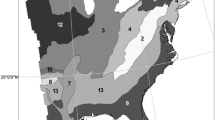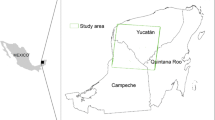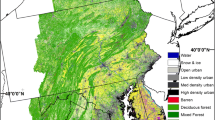Abstract
Robust monitoring of carbon sequestration by forests requires the use of multiple data sources analyzed at a common scale. To that end, model-based Moderate Resolution Imaging Spectroradiometer (MODIS) and field-based Forest Inventory and Analysis (FIA) data of net primary productivity (NPP) were compared at increasing levels of spatial aggregation across the eastern USA. A total of 52,167 FIA plots and colocated MODIS forest cover NPP pixels were analyzed using a hexagonal tiling system. A protocol was developed to assess the optimal scale as an optimal size of landscape patches at which to map spatially explicit estimates of MODIS and FIA NPP. The optimal mapping resolution (hereafter referred to as optimal scale) is determined using spatially scaled z-statistics as the tradeoff between increased spatial agreement as measured by Pearson’s correlation coefficient and decreased details of coverage as measured by the number of hexagons. Spatial sensitivity was also assessed using land cover assessment and forest homogeneity using spatially scaled z-statistics. Pearson correlations indicate that MODIS and FIA NPP are most highly correlated when using large hexagons, while z-statistics indicate an optimal scale at an intermediate hexagon size of 390 km2. This optimal scale had more spatial detail than was obtained for larger hexagons and greater spatial agreement than was obtained for smaller hexagons. The z-statistics for land cover assessment and forest homogeneity also indicated an optimal scale of 390 km2.



Similar content being viewed by others
References
Ahl, D. E., Gower, S. T., Mackay, D. S., Burrows, S. N., Norman, J. M., & Diak, G. R. (2005). The effects of aggregated land cover data on estimating NPP in northern Wisconsin. Remote Sensing of Environment, 97(1), 1–14. doi:10.1016/j.rse.2005.02.016.
Baldocchi, D. D. (2003). Assessing the eddy covariance technique for evaluating carbon dioxide exchange rates of ecosystems: Past, present and future. Global Change Biology, 9(4), 479–492. doi:10.1046/j.1365-2486.2003.00629.x.
Bettinger, P., Clutter, M., Siry, J., Kane, M., & Pait, J. (2009). Broad implications of southern United States pine clonal forestry on planning and management of forests. International Forestry Review, 11(3), 331–345.
Bian, L., & Butler, R. (1999). Comparing effects of aggregation methods on statistical and spatial properties of simulated spatial data. Photogrammetric Engineering and Remote Sensing, 65(1), 73–84.
Bian, L., & Walsh, S. J. (1993). Scale dependencies of vegetation and topography in a mountainous environment of Montana. The Professional Geographer, 45(1), 1–11. doi:10.1111/j.0033-0124.1993.00001.x.
Birdsey, R. (1996). Carbon storage for major forest types and regions in the conterminous United States. American Forests, 2, 261–371.
Blackard, J. A., Finco, M. V., Helmer, E. H., Holden, G. R., Hoppus, M. L., Jacobs, D. M., et al. (2008). Mapping US forest biomass using nationwide forest inventory data and moderate resolution information. Remote Sensing of Environment, 112(4), 1658–1677. doi:10.1016/j.rse.2007.08.021.
Brown, S. L., & Schroeder, P. E. (1999). Spatial patterns of aboveground production and mortality of woody biomass for eastern US forests. Ecological Applications, 9(3), 968–980.
Cirincione, C., Darling, T., & O'Rourke, T. (2000). Assessing South Carolina's 1990s congressional districting. Political Geography, 19(2), 289–211.
Coops, N. C., Waring, R. H., & Landsberg, J. J. (1998). Assessing forest productivity in Australia and New Zealand using a physiologically-based model driven with averaged monthly weather data and satellite-derived estimates of canopy photosynthetic capacity. Forest Ecology and Management, 104(1–3), 113–127.
Cressie, N. (1993). Aggregation in geostatistical problems (Geostatistics Troia '92). Dordrecht: Kluwer Academic.
Fisher, R. A. (1921). On the "probable error" of a coefficient of correlation deduced from a small sample. Metron, 1, 3–32.
Gotway, C. A., & Young, L. J. (2002). Combining incompatible spatial data. Journal of the American Statistical Association, 97(458), 632–648. doi:10.1198/016214502760047140.
Hay, G. J., Marceau, D. J., Dube, P., & Bouchard, A. (2001). A multiscale framework for landscape analysis: Object-specific analysis and upscaling. Landscape Ecology, 16(6), 471–490. doi:10.1023/a:1013101931793.
Heinsch, F. A., Zhao, M. S., Running, S. W., Kimball, J. S., Nemani, R. R., Davis, K. J., et al. (2006). Evaluation of remote sensing based terrestrial productivity from MODIS using regional tower eddy flux network observations. IEEE Transactions on Geoscience and Remote Sensing, 44(7), 1908–1925. doi:10.1109/tgrs.2005.853936.
Houghton, R. A., Hackler, J. L., & Lawrence, K. T. (1999). The US carbon budget: Contributions from land-use change. Science, 285(5427), 574–578.
Jelinski, D. E., & Wu, J. G. (1996). The modifiable areal unit problem and implications for landscape ecology. Landscape Ecology, 11(3), 129–140. doi:10.1007/bf02447512.
Jenkins, J. C., Kicklighter, D. W., Ollinger, S. V., Aber, J. D., & Melillo, J. M. (1999). Sources of variability in net primary production predictions at a regional scale: A comparison using PnET-II and TEM 4.0 in northeastern US forests. Ecosystems, 2(6), 555–570. doi:10.1007/s100219900102.
Jenkins, J. C., Birdsey, R. A., & Pan, Y. (2001). Biomass and NPP estimation for the mid-Atlantic region (USA) using plot-level forest inventory data. Ecological Applications, 11(4), 1174–1193.
Jenkins, J., Chojnacky, D., Heath, L., & Birdsey, R. (2004). Comprehensive database of diameter-based biomass regressions for North American tree species. Newtown Square: US Department of Agriculture, Forest Service, Northeastern Research Station. (45 pp).
Knight, J. F., & Lunetta, R. S. (2003). An experimental assessment of minimum mapping unit size. IEEE Transactions on Geoscience and Remote Sensing, 41(9), 2132–2134. doi:10.1109/tgrs.2003.816587.
Kwon, Y., & Larsen, C. (2012). Use of pixel- and plot-scale screening variables to validate MODIS GPP predictions with Forest Inventory and Analysis NPP measures across the eastern USA. International Journal of Remote Sensing, 33(19), 6122–6148.
Loehle, C., & LeBlanc, D. (1996). Model-based assessments of climate change effects on forests: A critical review. Ecological Modelling, 90(1), 1–31.
Lu, D. S. (2006). The potential and challenge of remote sensing-based biomass estimation. International Journal of Remote Sensing, 27(7), 1297–1328. doi:10.1080/01431160500486732.
McRoberts, R. E., Bechtold, W. A., Patterson, P. L., Scott, C. T., & Reams, G. A. (2005). The enhanced forest inventory and analysis program of the USDA Forest Service: Historical perspective and announcement of statistical documentation. Journal of Forestry, 103(6), 304–308.
Meentemeyer, V. (1989). Geographical perspectives of space, time, and scale. Landscape Ecology, 3(3–4), 163–173. doi:10.1007/bf00131535.
Monteith, J. L. (1972). Climate and efficiency of crop production in Britain. Philosophical Transactions of the Royal Society of London, 281, 277–294.
Muukkonen, P., & Heiskanen, J. (2007). Biomass estimation over a large area based on standwise forest inventory data and ASTER and MODIS satellite data: A possibility to verify carbon inventories. Remote Sensing of Environment, 107(4), 617–624. doi:10.1016/j.rse.2006.10.011.
Nayak, R. K., Patel, N. R., & Dadhwal, V. K. (2010). Estimation and analysis of terrestrial net primary productivity over India by remote-sensing-driven terrestrial biosphere model. Environmental Monitoring and Assessment, 170(1–4), 195–213. doi:10.1007/s10661-009-1226-9.
Openshaw, S., & Taylor, P. (1979). A million or so correlation coefficients: Three experiments on the modifiable area unit problem. In N. Wrigley (Ed.), Statistical applications in the spatial sciences. London: Pion.
Pan, Y., Birdsey, R., Hom, J., McCullough, K., & Clark, K. (2006). Improved estimates of net primary productivity from MODIS satellite data at regional and local scales. Ecological Applications, 16(1), 125–132.
Potter, C., Gross, P., Klooster, S., Fladeland, M., & Genovese, V. (2008). Storage of carbon in US forests predicted from satellite data, ecosystem modeling, and inventory summaries. Climatic Change, 90(3), 269–282. doi:10.1007/s10584-008-9462-5.
Riemann, R., Wilson, B. T., Lister, A., & Parks, S. (2010). An effective assessment protocol for continuous geospatial datasets of forest characteristics using USFS Forest Inventory and Analysis (FIA) data. Remote Sensing of Environment, 114(10), 2337–2352. doi:10.1016/j.rse.2010.05.010.
Running, S. W., Nemani, R. R., Heinsch, F. A., Zhao, M. S., Reeves, M., & Hashimoto, H. (2004). A continuous satellite-derived measure of global terrestrial primary production. BioScience, 54(6), 547–560.
Shifley, S. R., Aguilar, F. X., Song, N., Stewart, S. I., Nowak, D. J., Gormanson, D. D., et al. (2012). Forests of the Northern United States. Newtown Square: US Department of Agriculture, Forest Service, Northeastern Research Station. (202 pp).
Tan, B., Woodcock, C. E., Hu, J., Zhang, P., Ozdogan, M., Huang, D., et al. (2006). The impact of gridding artifacts on the local spatial properties of MODIS data: Implications for validation, compositing, and band-to-band registration across resolutions. Remote Sensing of Environment, 105(2), 98–114. doi:10.1016/j.rse.2006.06.008.
Tang, G., Beckage, B., Smith, B., & Miller, P. A. (2010). Estimating potential forest NPP, biomass and their climatic sensitivity in New England using a dynamic ecosystem model. Ecosphere, 1(16), art18, doi:10.1890/ES10-00087.1.
Tomppo, E., Olsson, H., Stahl, G., Nilsson, M., Hagner, O., & Katila, M. (2008). Combining national forest inventory field plots and remote sensing data for forest databases. Remote Sensing of Environment, 112(5), 1982–1999. doi:10.1016/j.rse.2007.03.032.
Turner, D. P., Ollinger, S., Smith, M. L., Krankina, O., & Gregory, M. (2004). Scaling net primary production to a MODIS footprint in support of Earth observing system product validation. International Journal of Remote Sensing, 25(10), 1961–1979.
Turner, D. P., Ritts, W. D., Cohen, W. B., Gower, S. T., Running, S. W., Zhao, M. S., et al. (2006). Evaluation of MODIS NPP and GPP products across multiple biomes. Remote Sensing of Environment, 102(3–4), 282–292. doi:10.1016/j.rse.2006.02.017.
Wang, Y. J., Woodcock, C. E., Buermann, W., Stenberg, P., Voipio, P., Smolander, H., et al. (2004). Evaluation of the MODIS LAI algorithm at a coniferous forest site in Finland. Remote Sensing of Environment, 91(1), 114–127. doi:10.1016/j.rsc.2004.02.007.
Waring, R. H., Coops, N. C., & Landsberg, J. J. (2010). Improving predictions of forest growth using the 3-PGS model with observations made by remote sensing. Forest Ecology and Management, 259(9), 1722–1729. doi:10.1016/j.foreco.2009.05.036.
White, D., Kimerling, A. J., & Overton, W. S. (1992). Cartographic and geometric components of a global sampling design for environmental monitoring. Cartography and Geographic Information Systems, 19(1), 5–22.
White, J. D., Scott, N. A., Hirsch, A. I., & Running, S. W. (2006). 3-PG productivity modeling of regenerating Amazon forests: Climate sensitivity and comparison with MODIS-derived NPP. Earth Interactions, 10, 1–25.
Wu, J. (1999). Hierarchy and scaling: Extrapolating information along a scaling ladder. Canadian Journal of Remote Sensing, 25, 367–380.
Wu, H., & Li, Z. L. (2009). Scale issues in remote sensing: A review on analysis, processing and modeling. Sensors, 9(3), 1768–1793. doi:10.3390/s90301768.
Wu, J., Jelinski, D. E., Luck, M., & Tueller, P. T. (2000). Multiscale analysis of landscape heterogeneity: Scale variance and pattern metrics. Geographic Information Sciences, 6(1), 6–19.
Zhang, X. Y., & Kondragunta, S. (2006). Estimating forest biomass in the USA using generalized allometric models and MODIS land products. Geophysical Research Letters, 33(9), doi:L0940210.1029/2006gl025879.
Zhao, M., & Running, S. W. (2010). Drought-induced reduction in global terrestrial net primary production from 2000 through 2009. Science, 329(5994), 940–943. doi:10.1126/science.1192666.
Zhao, M., & Running, S. W. (2011). Response to comments on "Drought-induced reduction in global terrestrial net primary production from 2000 through 2009". Science, 333(6046), doi:10.1126/science.1199169.
Zhao, M., Heinsch, F. A., Nemani, R. R., & Running, S. W. (2005). Improvements of the MODIS terrestrial gross and net primary production global data set. Remote Sensing of Environment, 95(2), 164–176. doi:10.1016/j.rse.2004.12.011.
Zhao, M., Running, S. W., & Nemani, R. R. (2006). Sensitivity of Moderate Resolution Imaging Spectroradiometer (MODIS) terrestrial primary production to the accuracy of meteorological reanalyses. Journal of Geophysical Research-Biogeosciences, 111(G1), doi:10.1029/2004jg000004.
Author information
Authors and Affiliations
Corresponding author
Rights and permissions
About this article
Cite this article
Kwon, Y., Larsen, C.P.S. An assessment of the optimal scale for monitoring of MODIS and FIA NPP across the eastern USA. Environ Monit Assess 185, 7263–7277 (2013). https://doi.org/10.1007/s10661-013-3099-1
Received:
Accepted:
Published:
Issue Date:
DOI: https://doi.org/10.1007/s10661-013-3099-1




